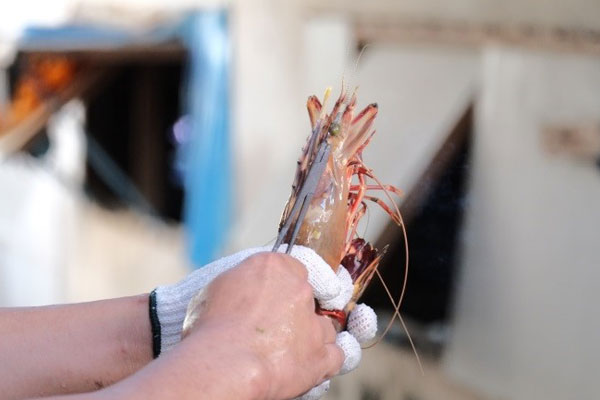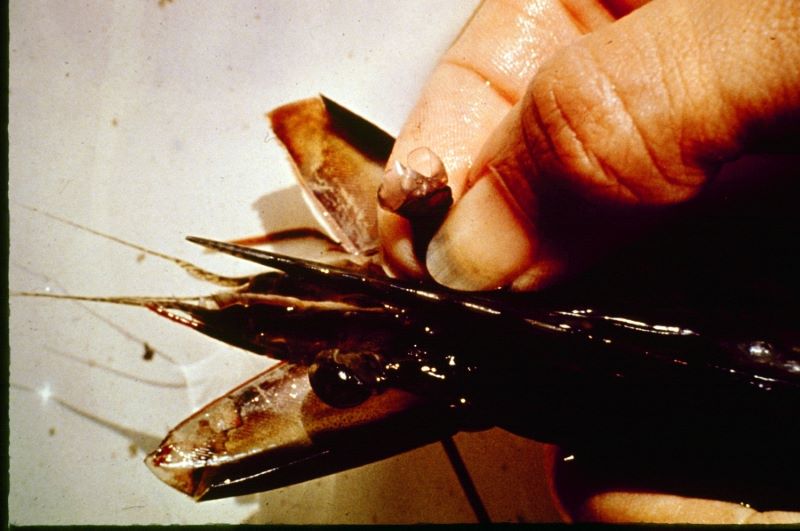[vc_row thb_full_width=”true” full_height=”yes” rtl_reverse=”yes” content_placement=”middle” css=”.vc_custom_1627538828154{padding-top: 0px !important;padding-bottom: 0px !important;background-image: url(https://arcj.org/wp-content/uploads/2021/07/ebi-arc-1200.jpg?id=20282) !important;background-position: 0 0 !important;background-repeat: no-repeat !important;}” thb_divider_color=”#deecf7″][vc_column width=”1/2″][/vc_column][vc_column width=”1/2″][vc_column_text]
Did you know that in shrimp farms, one eye of the mother shrimp gets cut off?
[/vc_column_text][vc_column_text]
Shrimp and prawn farms generally cut one eye off of the female.
This is to remove the hormone that regulates breeding, so that they can begin laying eggs faster.
What if you, or your mom, gets the eye taken away like this?
Recipes without sacrifice below ?
[/vc_column_text][/vc_column][/vc_row][vc_row thb_full_width=”true” rtl_reverse=”yes” content_placement=”middle” thb_divider_position=”top” css=”.vc_custom_1627536055346{padding-top: 70px !important;padding-bottom: 70px !important;background-color: #deecf7 !important;}”][vc_column][vc_row_inner max_width=”true” rtl_reverse=”yes”][vc_column_inner][vc_column_text animation=”animation fade-in”]
Most shrimps and prawns sold in Japan are farmed
Over 90% of shrimps and prawns sold in Japan are imported, amounting to about 6 billion shrimps/prawns imported every year [1].
Of those, about 80% come from Asian countries like India, Vietnam, and Indonesia [2].
Almost all of them are farmed, so you can assume that the majority of shrimps/prawns eaten in Japan come from aquaculture farms in Asia.
Not conducive to natural breeding in aquaculture environment
Compared to nature, shrimp/prawn farm environments are crowded, dirty, and prone to diseases,
so the ovaries don’t reach the final maturation stage [3].
To force them to breed nevertheless, it has become common to brutally remove the eyestalks that contain the gonad-inhibiting hormone [4].
Female shrimps and prawns get their eyes removed
Young female shrimps and prawns get their eyestalks cut off with heated forceps,
or get their eyes sliced open with knives and the internal content squeezed out with fingers,
all without anesthesia [5].
[/vc_column_text][vc_video link=”https://www.youtube.com/watch?v=PcpMSe8Q8VI”][thb_gap height=”50″][vc_column_text animation=”animation fade-in”]

Shrimps and prawns feel pain, too
In Japan, 3 out of 4 people seem to think that shrimps can’t feel suffering,
but it’s been scientifically proven that crustaceans feel pain as well.
In Australia, for example, a business that was chopping up lobsters alive was convicted.
Shrimps/prawns who get their eyes ablated get disoriented, flick their tails, and rub the injured areas [6].
Eyestalk ablation is unnecessary
This cruel practice has been shown to result in higher likelihood of diseases among the offspring,
and it’s been shown that by providing high quality feed, similar egg production can be achieved without eyestalk ablation [7].
This research result received the 2020 Innovation Award by the Global Aquaculture Alliance.

The cruel practice is being phased out
EU’s organic label has prohibited such eyestalk ablation since over 10 years ago.
The leading farmed shrimp producer in Latin America, SeaJoy, has been breeding shrimps without eyestalk ablation since 2016 by improving the breeding environment [8].
The world’s largest shrimp producer, CP Foods, also announced last year that they developed biotechnological innovation to eliminate eyestalk ablation [9].
[/vc_column_text][/vc_column_inner][/vc_row_inner][thb_gap height=”50″][thb_title style=”style2″ icon=”fas fa-fire-alt” title=”Please help end the suffering of shrimps/prawns in aquaculture!” accent_color=”#01c4bd”][/vc_column][/vc_row][vc_row thb_full_width=”true” row_padding=”true” column_padding=”false” css=”.vc_custom_1627536592474{padding-top: 100px !important;}” thb_divider_color=”#ffffff” thb_divider_height=”70″][vc_column][vc_column_text animation=”animation scale”]
What you can do for shrimps and prawns
[/vc_column_text][vc_column_text]
① Spread awareness by sharing!
[/vc_column_text][vc_row_inner el_class=”text-center”][vc_column_inner width=”1/2″][vc_btn title=”Facebook” style=”flat” shape=”round” color=”primary” size=”lg” align=”right” i_icon_fontawesome=”fas fa-share” css_animation=”flipInX” add_icon=”true” link=”url:https%3A%2F%2Fwww.facebook.com%2Fsharer.php%3Fsrc%3Dbm%26u%3Dhttps%3A%2F%2Farcj.org%2Fshrimp%2F||target:%20_blank|” css=”.vc_custom_1627886228769{margin-top: 20px !important;}”][/vc_column_inner][vc_column_inner width=”1/2″][vc_btn title=”Twitter” style=”flat” shape=”round” color=”info” size=”lg” align=”left” i_icon_fontawesome=”fas fa-retweet” css_animation=”flipInX” add_icon=”true” link=”url:http%3A%2F%2Ftwitter.com%2Fshare%3Furl%3Dhttps%3A%2F%2Farcj.org%2Fshrimp%2F%26hashtags%3D%E9%A4%8A%E6%AE%96%E3%82%A8%E3%83%93%E3%81%AE%E6%B6%88%E8%B2%BB%E6%B8%9B%E3%82%89%E3%81%9D%E3%81%86||target:%20_blank|” css=”.vc_custom_1627886266275{margin-top: 20px !important;}”][/vc_column_inner][/vc_row_inner][vc_column_text]
② Put up posters!
You can print the PDF below at convenience stores (it’s easy;), etc,
or we can send you posters (outdoor use possible)!
[/vc_column_text][vc_column_text]
③ Demand higher standards from certification labels
Please demand aquaculture certification labels to include non-ablation as a criteria in their standards.
Please demand this minimum animal welfare standard, which should be a matter of course if you think about it.
By not approving such horrific practice, aquaculture certifiers could become a world leader in the industry in which animal welfare is becoming increasingly important.
Please send your opinions to the most common aquaculture certifiers in Japan, ASC and MEL!
[/vc_column_text][vc_column_text]
④ Let’s reduce shrimp/prawn consumption!
If we lower the consumption of farmed shrimps and prawns, there will be less victims who get their eyes taken away.
To eliminate the suffering of the annual 6 billion shrimps and prawns and of the mothers giving birth to them,
let’s make the choice to leave farmed shrimps and prawns off of our plates.
[/vc_column_text][vc_column_text]
Have a try at restaurants and recipes without animal sacrifice!
[/vc_column_text][vc_hoverbox image=”7779″ primary_title=”ヴィーガン&エシカルな情報サイト Hachidory” primary_title_font_container=”font_size:26|color:%23ffffff” primary_title_google_fonts=”font_family:Open%20Sans%3A300%2C300italic%2Cregular%2Citalic%2C600%2C600italic%2C700%2C700italic%2C800%2C800italic|font_style:600%20bold%20regular%3A600%3Anormal” primary_title_css_animation=”bounceIn” hover_title=”” hover_background_color=”mulled-wine” el_width=”40″ hover_btn_title=”ヴィーガン&エシカルな情報をHachidoryで探す” hover_btn_color=”turquoise” hover_btn_size=”lg” hover_btn_align=”center” hover_btn_i_icon_fontawesome=”fab fa-accessible-icon” hover_btn_css_animation=”bounceIn” css_animation=”appear” use_custom_fonts_primary_title=”true” hover_add_button=”true” hover_btn_button_block=”true” hover_btn_add_icon=”true” hover_btn_link=”url:http%3A%2F%2Fwww.hachidory.com%2F||target:%20_blank|” primary_title_link=”url:http%3A%2F%2Fwww.hachidory.com%2F||target:%20_blank|”]ベジレス、ヴィーガン対応宿、レシピ、ヴィーガンアーティストなどヴィーガン&エシカルな生活をおくるための情報をお届け。
動物の犠牲がないレシピ、レストラン、宿、カルチャーなど情報いっぱい。
 [/vc_hoverbox][vc_row_inner max_width=”true” el_class=”text-center” css=”.vc_custom_1555233012637{padding-top: 8vh !important;padding-bottom: 5vh !important;}”][vc_column_inner][vc_separator color=”turquoise” style=”dotted” border_width=”4″ el_width=”10″ css=”.vc_custom_1627537276289{padding-top: 20px !important;padding-bottom: 20px !important;}”][vc_column_text]
[/vc_hoverbox][vc_row_inner max_width=”true” el_class=”text-center” css=”.vc_custom_1555233012637{padding-top: 8vh !important;padding-bottom: 5vh !important;}”][vc_column_inner][vc_separator color=”turquoise” style=”dotted” border_width=”4″ el_width=”10″ css=”.vc_custom_1627537276289{padding-top: 20px !important;padding-bottom: 20px !important;}”][vc_column_text]
Learn more about animal welfare, veganism, etc:
[/vc_column_text][vc_hoverbox image=”7796″ primary_title=”Animal Rights Center Japan – English website” primary_title_font_container=”font_size:24|color:%23ffffff” primary_title_google_fonts=”font_family:Open%20Sans%3A300%2C300italic%2Cregular%2Citalic%2C600%2C600italic%2C700%2C700italic%2C800%2C800italic|font_style:600%20bold%20regular%3A600%3Anormal” primary_title_css_animation=”bounceIn” hover_title=”” el_width=”50″ hover_btn_title=”畜産動物の状況をいますぐ知る” hover_btn_color=”danger” hover_btn_size=”lg” hover_btn_align=”center” hover_btn_i_type=”material” hover_btn_i_icon_material=”vc-material vc-material-goat” hover_btn_css_animation=”bounceIn” css_animation=”appear” use_custom_fonts_primary_title=”true” hover_add_button=”true” hover_btn_button_block=”true” hover_btn_add_icon=”true” hover_btn_link=”url:https%3A%2F%2Fwww.hopeforanimals.org%2F||target:%20_blank|” primary_title_link=”url:https%3A%2F%2Farcj.org%2Fen%2F||target:%20_blank|”]鶏、豚、牛、フォアグラにされる鴨、700億頭が毎年犠牲になります。
畜産動物の情報を深く知り、改善に向けた一歩を。 [/vc_hoverbox][/vc_column_inner][/vc_row_inner][vc_column_text]
[/vc_hoverbox][/vc_column_inner][/vc_row_inner][vc_column_text]
More details about eyestalk ablation [1] https://umito.maruha-nichiro.co.jp/article31/ [2] https://www.maff.go.jp/j/heya/kodomo_sodan/0308/02.html [3] https://www.sciencedirect.com/science/article/abs/pii/S0044848696014081 [4] https://journals.plos.org/plosone/article?id=10.1371/journal.pone.0024427 [5] https://www.animalsaustralia.org/features/prawn-farming.php [6] https://www.researchgate.net/publication/271883879_Eyestalk_ablation_procedures_to_minimize_pain [7] https://www.aquaculturealliance.org/goal/innovation-award/ [8] https://www.seajoy.com/index.php/sustainable/non-ablation [9] https://www.cpfworldwide.com/en/sustainability/report
[/vc_column_text][/vc_column][/vc_row][vc_row thb_full_width=”true” row_padding=”true” column_padding=”false” css=”.vc_custom_1555424802071{padding-top: 0px !important;background-color: #84e4d9 !important;}” thb_divider_color=”#ffffff” thb_divider_height=”70″][vc_column][vc_row_inner max_width=”true” el_class=”text-center” css=”.vc_custom_1555233012637{padding-top: 8vh !important;padding-bottom: 5vh !important;}”][vc_column_inner width=”1/2″][vc_column_text css=”.vc_custom_1628039722284{padding-bottom: 20px !important;}”]
Please support our activities.
Animals are just enduring in suffering and hopelessness.
We thrive to put an end to this suffering.
[/vc_column_text][vc_btn title=”寄付をする” style=”flat” shape=”square” color=”pink” size=”lg” align=”center” i_icon_fontawesome=”fa fa-heart” button_block=”true” add_icon=”true” link=”url:http%3A%2F%2Farcj.sakura.ne.jp%2Fanimalrights%2Fdonate%2F|||” css=”.vc_custom_1555236090291{margin-top: 20px !important;}”][/vc_column_inner][vc_column_inner width=”1/2″][vc_video link=”https://www.youtube.com/watch?v=kQBw2qzopoY”][/vc_column_inner][/vc_row_inner][/vc_column][/vc_row][vc_row thb_full_width=”true” row_padding=”true” column_padding=”false” css=”.vc_custom_1556629909594{padding-top: 0px !important;background-color: #f7df56 !important;}” thb_divider_color=”#ffffff” thb_divider_height=”70″][vc_column][vc_row_inner max_width=”true” el_class=”text-center” css=”.vc_custom_1556720353699{padding-top: 5vh !important;}”][vc_column_inner][vc_column_text css=”.vc_custom_1628039792114{padding-bottom: 20px !important;}”]
Follow Animal Rights Center Japan
Get news about the current situations of animals and actions to take.
[/vc_column_text][/vc_column_inner][/vc_row_inner][vc_row_inner max_width=”true” el_class=”text-center” css=”.vc_custom_1556720019040{padding-bottom: 5vh !important;}”][vc_column_inner width=”1/6″][vc_btn title=”Facebook” style=”flat” shape=”round” color=”primary” size=”lg” align=”center” i_icon_fontawesome=”fa fa-facebook-square” css_animation=”flipInX” add_icon=”true” link=”url:https%3A%2F%2Fwww.facebook.com%2FAnimalRightsCenter||target:%20_blank|” css=”.vc_custom_1556720294577{margin-top: 20px !important;}”][/vc_column_inner][vc_column_inner width=”1/6″][vc_btn title=”Twitter” style=”flat” shape=”round” color=”info” size=”lg” align=”center” i_icon_fontawesome=”fa fa-twitter-square” css_animation=”flipInX” add_icon=”true” link=”url:https%3A%2F%2Ftwitter.com%2Fanimalrights_JP||target:%20_blank|” css=”.vc_custom_1556720308806{margin-top: 20px !important;}”][/vc_column_inner][vc_column_inner width=”1/6″][vc_btn title=”Instagram” style=”flat” shape=”round” color=”mulled-wine” size=”lg” align=”center” i_icon_fontawesome=”fa fa-instagram” css_animation=”flipInX” add_icon=”true” link=”url:https%3A%2F%2Fwww.instagram.com%2Fanimalrightscenter%2F||target:%20_blank|” css=”.vc_custom_1556720320499{margin-top: 20px !important;}”][/vc_column_inner][vc_column_inner width=”1/2″ css=”.vc_custom_1556720170936{padding-right: 20px !important;padding-left: 20px !important;}”][vc_btn title=”メールニュースに登録” style=”flat” shape=”square” color=”turquoise” size=”lg” align=”center” i_icon_fontawesome=”fa fa-envelope-open” css_animation=”flipInX” button_block=”true” add_icon=”true” link=”url:https%3A%2F%2Fgroups.google.com%2Fforum%2F%23!forum%2Fanimalrightscenter%2Fjoin||target:%20_blank|” css=”.vc_custom_1556720334031{margin-top: 20px !important;}”][/vc_column_inner][/vc_row_inner][/vc_column][/vc_row]


